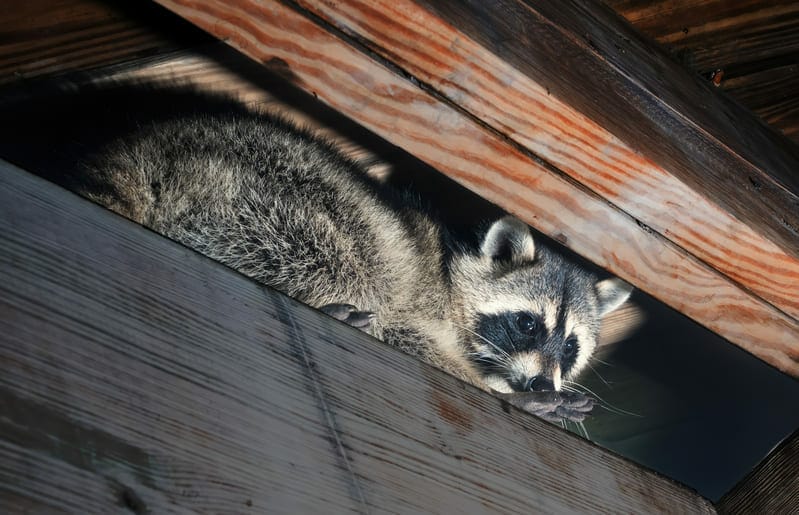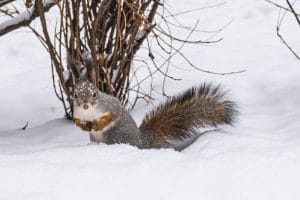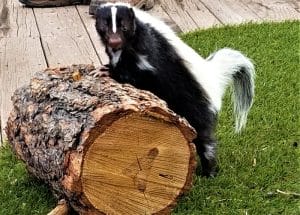We know you love animals- we do too! But we agree that not all of them belong in your home.
Unfortunately, a variety of critters are likely to find your home’s attic, wall spaces, and other tight spots an irresistible place to shelter over the winter and raise their young. Let’s show you how to spot signs of their presence, so you know when you need to schedule a humane wildlife removal in Hamilton, Oakville, Burlington, or wherever you live.
Quickly jump to any section in this post 🤔
Who’s Come to Visit?
You’re hearing scratches, chewing, and scampering about in your walls and attic. Droppings (and smelly ones, at that) are appearing near your baseboards and inside cupboards. Once in a while, you find pieces of food in interesting places. However, you haven’t seen anyone yet. How do you know who needs an eviction notice?
While the best way is to catch the invader in action, it’s not the only one. Let’s take a closer look at the different ways they let you know they’re home.

Mice removal is common
Mice are nocturnal creatures, so their activity will be subtle, but if you notice any of the following signs, you likely have an infestation and will need to schedule a humane eviction.
- Scratching in Walls and Ceilings: Mice infiltrate walls, ceilings, floors, and roof spaces, only coming out at night to search for food. In general, mice are quiet animals, but when they travel or prepare their nests, you may hear scratching noises.
- Droppings: Mice droppings are small (around 5mm in length)and dark. As mice prefer to stay away from open spaces, you may find their faeces in cabinets and along skirting boards. They can reach every corner of your home, so you may also find their waste on kitchen counters and window sills.
- Urine: If infestations have become particularly heavy, a mixture of mouse urine, grease, dirt, and hair can create so-called urine pillars. The presence of these small mounds indicates the space has been occupied by mice for some time.
- Grease Rubs: Mice have glands that produce oil to keep their coats healthy. When they move around a property, this oil, combined with hair and dirt, leaves marks known as grease rubs, usually when they brush up against walls, doors, or furniture.
- Tracks: No matter how often you clean, dust and dirt still accumulate in out-of-sight and hard-to-reach corners. Dusty areas can reveal evidence of mice, as mice leave tracks or tail marks as they move about.
- Damage to Furnishings and Food: Mice are expert foragers, so they can easily nibble their way into cereal or biscuit boxes or plastic containers. They also chew through furniture and furnishings, either to gain new access points or to gather materials for nests.
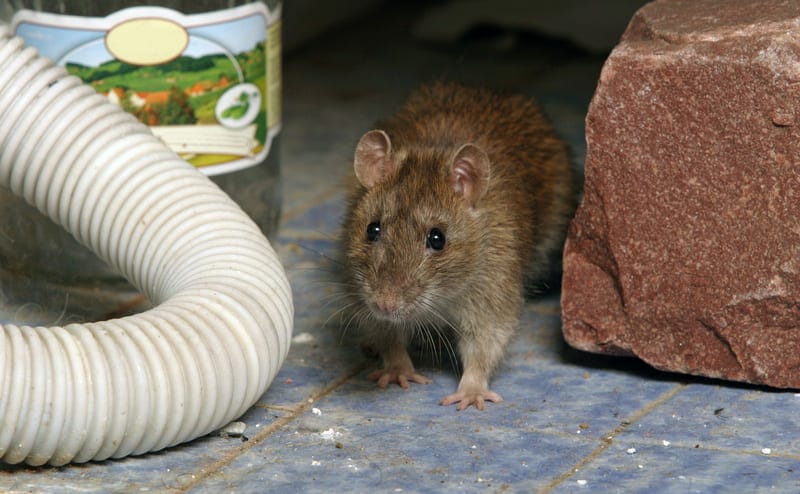
Rat Removal
Are you finding gnaw marks on electrical cords? Small dark droppings that are too big for mice to be the culprit? If so, a rat (or twenty) may have moved into those dark and comfortable spaces in your walls and attic.
Since rats are most active at night, it is often easier to spot signs of an infestation than the actual rats themselves. Below we explain some signs that you might have a rat problem.
- Droppings: Rats produce up to 40 droppings per night, so droppings tend to gather in certain locations. Brown rat droppings have a tapered, spindle shape and are dark brown in colour.
- Rub Marks: Since rats have poor eyesight, they follow familiar routes along baseboards and walls. When they repeatedly touch objects and surfaces, grease and dirt on their bodies leave dark smudges.
- Gnaw Marks: If you look in your attic and behind furniture, you may find wires, cables, or other items with gnaw marks. When rats chew, they make a distinct grinding noise with their teeth, which is another sign of their presence.
- Rat Holes: Brown rats will dig elaborate burrow systems for shelter, food storage, and nesting. Since they dig their burrows near solid objects or structures, you may find entrance holes at the base of a wall or in your attic.
- Rat Nests: Rats nest not only in burrows but also in lofts, attics, under eaves, and even in cavity walls. They will shred loft insulation, cardboard, and other soft items to make nests.
- Footprints: Rats leave foot and tail prints in dusty, less-used areas. To determine if an infestation is active, sprinkle talcum powder or flour in the area near the footprints and check for fresh tracks the next day.
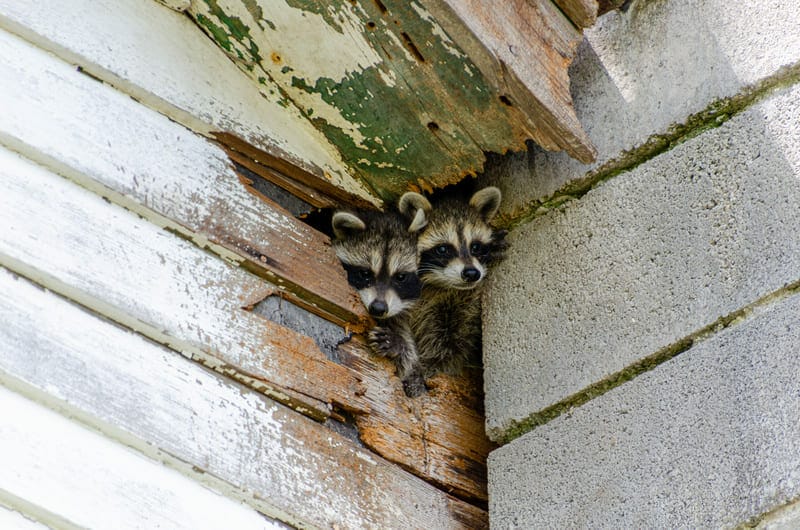
Get rid of Raccoons Humanely
Known for their adaptability, raccoons have been moving from their native wilderness habitat into urban areas for decades. They’re cute, but they’re also so sneaky that they can get into your house without you even knowing- until the signs of their presence are too obvious to ignore.
- Garbage Invasions: If your garbage is constantly being invaded, you almost certainly have a raccoon. Attracted by the smell from the containers, they will do whatever it takes to reach the discarded food inside. Whenever you find yourself struggling to contain your trash, a black-eyed bandit is probably at work.
- Tracks: Raccoon tracks are most frequently found around fence lines, near buildings, around trees, and near garbage containers. If you find prints that resemble tiny human footprints in and around your home, it may be time for raccoon removal services.
- Droppings: Racoons usually leave droppings at the bottom of trees, near piles of wood, and in similar locations. If you see signs of raccoon droppings in these locations, they’re in the vicinity, so take a closer look inside your home, specifically the attic.
- Scratches: Most raccoons leave scratch marks as a sign of their presence, especially on porches, sheds, and other property structures. If you notice these marks outside your home, look inside. You might find a visitor!
- Strange Noises: Studies have shown that raccoons can produce more than fifty unique sounds. You may hear growls, squeals, chirping noises, snorts, and snarls, as well as high-pitched squeals. When you hear unusual sounds that can’t be attributed to your dog or cat, chances are you are hearing raccoons.

Remove squirrels from your home safely
You’ve probably noticed squirrels in trees or on utility lines around your property, but have they actually gotten into your home? Here are some signs you have a bushy-tailed visitor who might decide that your attic is a great place to raise a family come spring? You might need squirrel removal!
- Strange Odours: If you’re sure you’ve cleaned your home thoroughly and you’re still smelling something strange, your new rodent roommate may be to blame. Since salmonella and Lyme disease can be transmitted to humans through dust exposed to squirrel excrement, you’ll want to take action quickly.
- Droppings: In most cases, you’ll smell animals before you see them, but there are times when you might get visual cues before you smell them. The presence of animal faeces inside the home is a sign of an infestation. Squirrel droppings are visually similar to bat droppings, so don’t confuse them.
- Signs of Chewing: Squirrels are like any other rodent in that they chew to keep their teeth from getting too long. You may notice gnawed siding and shingles or damaged entry points that squirrels have used to gain access to your home. Once they get in, you may find chewed-up storage boxes, wooden posts, or planks in your attic.
- Nests: You’ll know you have a squirrel infestation if you come across a nest. Squirrels use anything from insulation to leaves and twigs to build cozy nests for themselves and their families. When you see a nest, it’s time to schedule an eviction.
- Acorns: Squirrels often gather acorns during the summer and fall months and store them for consumption in the colder seasons. If you see acorns in your attic, it’s likely they didn’t get there on their own.
- Strange Noises: Squirrels make scampering or skittering noises in your walls or ceiling. If they get stuck, they make scratching sounds. This could happen if a squirrel falls down a chimney or gets trapped in your wall. Don’t ignore these warning signs, as they could lead to much bigger problems.
How Does Humane Wildlife Eviction Work?
When you contact Bad Company Wildlife Eviction, we examine your home from top to bottom, checking for signs of animal presence. As soon as we suspect an infestation, we locate common entry points, note them, and provide you with some repair and maintenance recommendations that can help prevent the animals from returning.
If we find baby animals, we ensure that they won’t be left behind during the eviction. Rather than leave them in the residence, we move them to an insulated, heated box located near the one-way door (more on that below). Mothers generally return and move their babies one by one to their new homes once they determine it is safe to do so.
After all entry points have been identified, our technicians install one-way exits that allow animals to leave but not return. Preventive screening and caulking are used to seal weak points and prevent animals from re-entering. These one-way exits will be removed later, once we’re sure that your ‘guests’ have left the property, and the openings will be permanently sealed.
Should You Try a DIY Eviction?
Many online articles provide detailed instructions for removing animals yourself. However, we recommend that you do not follow them for the reasons listed below.
- Trapping and removing wildlife is only a temporary solution and is illegal over 1km for endangered species. Food, water, and a safe nesting area attract animals. As long as these attractants are present, other animals will simply replace the relocated ones.
- There might not be professional resources available to you, like one-way doors, which are designed to keep animals out without harming them.
- You might cause unnecessary suffering if you separate a mother from her young.
Bad Company Wildlife Eviction provides animal eviction services safely and effectively, without harming our technicians or the wildlife, especially the young. You will also receive advice and recommendations to prevent such problems from occurring again in the future. You are welcome to contact us if you have any questions or concerns following an eviction.
How Much Does Humane Wildlife Eviction Cost?
Because each property and eviction requirement differs, it’s difficult to provide a price before your home has been inspected. As soon as you contact us to report your unwanted houseguests, we will send a wildlife eviction specialist to inspect your home and identify entry and exit points. Then we will explain our removal process and provide you with an estimate so you can decide whether you want to go ahead with the eviction process.
Tips for Preventing Further Drop-Ins
- Clutter can make it difficult to spot signs of pest invasion in areas such as your attic, basement, or garage. By regularly decluttering your home, you’ll keep animals from nesting in the house unnoticed.
- Food and water sources should be removed both outside and inside the home to discourage hungry, unwanted guests. This includes leaky faucets, pet food and water dishes, unsecured garbage bins, and natural food sources like fallen acorns and fruit. In your kitchen, store items like pet food, bread, and cereal in glass or metal containers.
- Animals seeking shelter may use branches, shrubs, and vines to gain access to your home. Trim all the plants around your home to remove these natural bridges. Squirrels can jump up to six feet, so trim branches within two metres of your roof and windows.
- Larger animals, like raccoons and skunks, may consider your chimney a warm place to rest. Invest in a chimney cap to keep wildlife from getting inside and possibly trapped.
- If you have a woodpile somewhere on your property, store it at least 20 feet from your home, as woodpiles can attract rodents and insects such as beetles and termites.
If you suspect that your home isn’t entirely critter-proof, let Bad Company Wildlife Eviction complete a thorough inspection for potential vulnerabilities. In addition to evicting unwanted guests, we can also help you develop a plan for keeping your home critter-free in the future.
Need Humane Wildlife Removal in Hamilton, Burlington, or Anywhere Else?
At Bad Company Wildlife Eviction, we’re really animal lovers at heart, and it shows in everything we do, from careful, low-stress removal to strategic relocation. You can call us knowing that your furry visitors’ wellbeing is our top priority from the beginning to the end. To learn more about our humane wildlife eviction services and schedule a no-obligation inspection, call 1-855-880-9860 or contact us online.

